Running an Advanced Search (Navigation Mode) | |||||||
|
| ||||||
From the global toolbar, select
 > Search.
> Search.
or
Select Add Existing from the page Actions menu or toolbar.
or
Click
 next to the field where you need to search
for a value.
next to the field where you need to search
for a value.or
Enter a search string in the Search box on the global toolbar and click
 .
.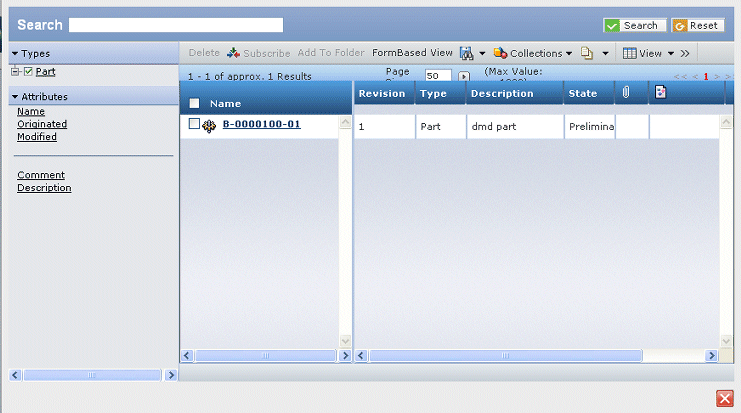
If you print or export this page, only the results list is included; the Type, Library, and Attribute list is not included. See Search Results for information about the result columns.
To switch to the form-based indexed search page, click Form Based View. Not all search pages have this button.
To filter the results list based on a collection, select Collections > and the name of the collection. The results list shows only those objects in the selected collection that meet the criteria.
To filter the results list based on object type:
If your system includes Library Central your page may show a Library list below the Types list. Selecting libraries works the same way as selecting types.
-
Click a type name in the Types list. The Type list is updated to show
only the selected type and its children, and the results list is updated
to show only objects with that type. Selecting a type is the same as
searching for that specific type.
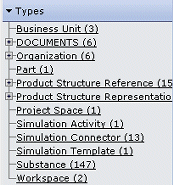
For example, if you click on DOCUMENTS, types that are not DOCUMENTS or children of DOCUMENTS are removed from the list. If you then click on Specification, the list removes all other children types of DOCUMENTS. The check boxes show your choices.
- Click a child type to further narrow the list.
- Click a parent type to remove the child type criteria.
-
Click a type name in the Types list. The Type list is updated to show
only the selected type and its children, and the results list is updated
to show only objects with that type. Selecting a type is the same as
searching for that specific type.
To filter the results list based on attribute values:
-
Click an Attribute name.
If the attribute contains a range of values, a list box of values for that attribute pops open and you can click the needed value(s).
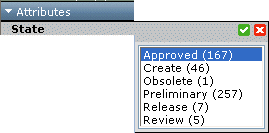
The numbers after the value indicate how many objects have that value. Some attributes allow you to select more than one value. Use shift-click to select a range of values; use control-click to select individual values.
If the attribute contains numeric values (and there are many values), a box opens where you select a compare operator (= equals, > greater than, < less than, or between) and enter a value.

If the attribute contains dates (and there are many values) you can select On, On or after, On or before, or Between and enter a value. Use the calendar tool to enter date values. If there are fewer than a system-set value (the default is 10), the values show as a list.
If the attribute contains yes/no values, click the option button for Yes or No.
If the attribute includes a unit of measure, enter a value and select the units.
-
Click
 . The results are filtered
based on objects that have that value for that attribute. If you selected
a date range, a numeric range, or multiple values for an attribute, a
column for that attribute is added to the results table.
. The results are filtered
based on objects that have that value for that attribute. If you selected
a date range, a numeric range, or multiple values for an attribute, a
column for that attribute is added to the results table.
If you defined a custom view for the results table, the column is only added if you had previously added it to the list of visible columns. If not, the system adds it to the list of available columns and you can edit your custom view to include it.
-
Continue selecting values for attributes as needed to filter the results
list.
The checked items at the top of the navigation list show the criteria used to generate the results list, called a breadcrumb trail.
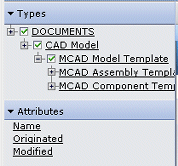
For example, DOCUMENTS is chosen from the list of Types, then CAD Model is chosen, followed by MCAD Model Template.
-
Click an Attribute name.
To search for specific text in any attribute of an object:
When using the search field, your results include all objects that have that value for any attribute. For example, if you enter "Plastic*" in the full-text search field, the system finds all objects that include Plastic in any field. If you only want to find items that have a Material Type of Plastic, then search specifically on that field.
-
Type the keyword or text string in the Search box.
Your system has a minimum required number of characters (default is 3) when using a wildcard. For example, you can enter "Pro*" in the box, but not "Pr*". Your Business Administrator may have increased or decreased this minimum.
You cannot use a single wildcard character in a multiword query that has spaces between the words unless the wildcard appears at the end of the query. Use a second wildcard to balance the first wildcard. For example, the queries "the cow jumped" and "the cow jumped*" are valid and the queries "th* cow jumped" and "t*e cow jumped" are not valid.
- Click Search.
-
If you see a "Did You Mean" message, the search tool has found 1 or
more terms that are close to but more common than the one you entered.
Click a word or phrase to search for it.
The results section is updated to show objects that contain that text as any attribute value. The search is not case-sensitive and the results include all matches based on pieces of the given string. Non-alphanumeric characters are not recognized by the search engine.

If the searched-for text is found more than once for an object, a single row presents the found data for that object (not a separate row for each time the searched-for text is found), without indicating where the text was found.
-
Type the keyword or text string in the Search box.
To search combination fields (where the search attribute combines individual attributes, such as Configuration Feature):
-
Click the attribute name.
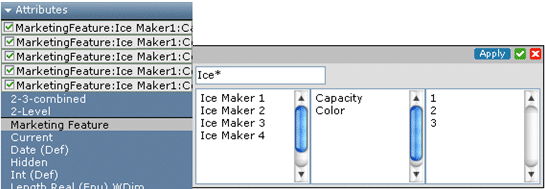
- In the text box above the list boxes, enter search text. You can use the * and ? wildcards.
- Click a value in each of the list boxes.
-
Click
 . The results are filtered
based on the combination of attributes.
. The results are filtered
based on the combination of attributes.
-
Click the attribute name.
To sort the search results, click the arrow next to a column name.
Your ENOVIA platform has a threshold value set (default is 1000, but your Business Administrator may have changed the value). If the results exceed this threshold, the results are sorted over all pages; if the results are less than this threshold, only the current page is sorted.
To change the number of rows in the search results, enter an integer in the Page Size box and click the button next to it. The number after that button indicates the maximum number you can enter.
To save the search criteria, including the Type and Attribute selections:
-
Click
 > Save
As.
> Save
As.
- Enter a name for the search, or select an existing search to overwrite it.
- Click Done.
-
Click
To re-execute a saved search, click
 and click the name of
the search.
and click the name of
the search.
To clear all search criteria, click Reset.
To add selected items to a collection, click Collections, and then click:
- Add to Clipboard Collection. Adds the items to your clipboard collection.
- New / Add to Collections. Opens the Select Collection dialog.
Click Done.